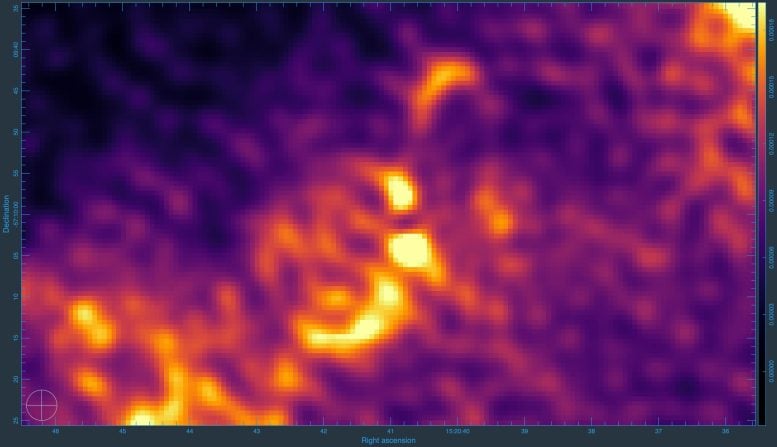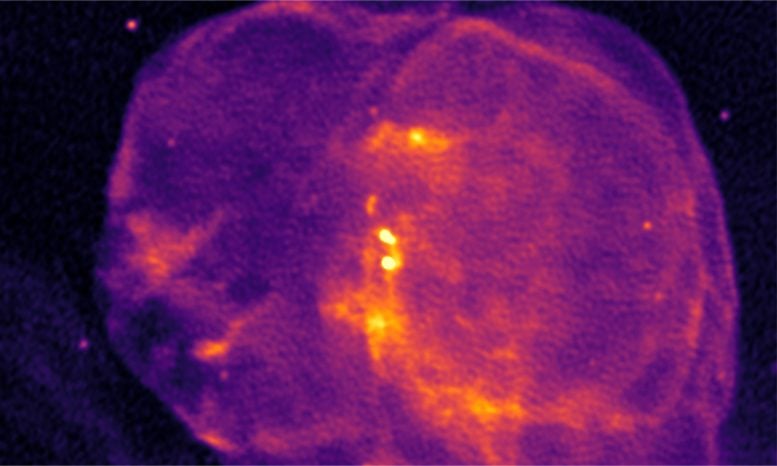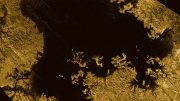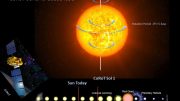
Radio image of the S-shaped precessing jet launched by the neutron star in Circinus X-1. Both Cir X-1 itself (center of the image) and a background source have been subtracted from the image to make the S-shape clearer. The jets are fast, narrow flows of material outwards from Cir X-1. The size of the jets against the sky is the same apparent size as a penny viewed from 100 meters away, but their real size is greater than five light-years. Credit: Fraser Cowie
For the first time, astronomers have captured an image of a neutron star emitting a ‘garden sprinkler-like’ S-shaped jet in the binary system Circinus X-1, located over 30,000 light-years away.
This phenomenon, similar to precession observed in black holes, illustrates the jet’s direction change due to the gravitational pull from a disc of hot gas. The discovery was made using the MeerKAT radio telescope, and the findings provide insights into the dynamics of neutron stars and the mechanics of jet launching.
A strange ‘garden sprinkler-like’ jet coming from a neutron star has been pictured for the first time.
The S-shaped structure is created as the jet changes direction due to the wobbling of the disc of hot gas around the star – a process called precession, which has been observed with black holes but, until now, never with neutron stars.
Animation of moving termination shocks from Circinus-1. These are regions where the jet violently rams into the surrounding material causing a shockwave travelling at a significant fraction of the speed of light. Credit: Fraser Cowie
Cosmic Phenomena in Circinus X-1
This particular object sits in the binary system Circinus X-1 more than 30,000 light-years from Earth and formed from the core of a massive supergiant star that collapsed around the same time Stonehenge was built.
It is so dense that a teaspoon of its material weighs as much as Mount Everest.
Binary systems have two stars that are bound together by gravity. In the case of Circinus X-1, one of these is a neutron star.
Both neutron stars and black holes are cosmological monsters that form when the biggest stars in the Universe die and collapse under their own gravity.
However, the latter are considerably more massive and can only be detected through their gravitational effects, while the former can be observed directly despite their denseness.
They are some of the most extreme objects in the Universe and have interiors almost entirely made of neutrons.

Radio image from the MeerKAT telescope showing Circinus X-1 in the center, within the spherical remnant of the supernova it was born in. The shockwaves caused by the jets are seen above and below Cir X-1, and the S-shape structure in the jets is somewhat obscured by a bright source in the background. Credit: Fraser Cowie
Observations With MeerKAT
The jet emanating from the neutron star was spotted by a team of astronomers at the University of Oxford, who used MeerKAT — a radio telescope in South Africa — to create the most detailed, high-resolution images of Circinus X-1.
The pictures, which were presented at this week’s National Astronomy Meeting at the University of Hull, include the first-ever image of an S-shaped jet coming from a confirmed neutron star – a breakthrough that could help unravel the extreme physics behind the astronomical phenomenon.
Lead researcher Fraser Cowie said there was another system known for its S-shaped jets, called SS433, but recent results suggest that object is likely a black hole.
“This image is the first time we have seen strong evidence for a precessing jet from a confirmed neutron star,” he said.
“This evidence comes from both the symmetric S shape of the radio-emitting plasma in the jets and from the fast, wide shockwave, which can only be produced by a jet changing direction.
“This will give valuable information about the extreme physics behind the launching of the jet, a phenomenon which is still not well understood.”
Accretion and Jet Dynamics
The neutron star’s huge density creates a strong force of gravity that strips gas from the companion star, forming a disc of hot gas around it that spirals down toward its surface.
This process, called accretion, releases huge amounts of energy per second with more power than a million Suns. Some of this energy powers jets – narrow beams of outflowing material from the binary system traveling close to the speed of light.
Recent upgrades to the MeerKAT telescope have resulted in excellent sensitivity and higher-resolution images. With these, the team saw clear evidence of an S-shaped structure, similar in shape to water spraying from a garden sprinkler, in Circinus X-1’s jet.
Not only that, but researchers also discovered moving termination shocks – the first recorded from an X-ray binary. These are regions where the jet violently rams into the surrounding material, causing a shockwave.
Cowie’s team measured the waves moving at roughly 10 percent of the speed of light, confirming that they were caused by the fast-moving jet and not something slower such as a wind of material from the stars.
“The fact that these shockwaves span a wide angle agrees with our model,” Cowie said. “So we have two strong pieces of evidence telling us the neutron star jet is precessing.”
Measuring the velocity of the shockwaves will also help astronomers understand what the jet causing them is made from.
The shockwaves effectively act as particle accelerators in space — producing high-energy cosmic rays — and the maximum energy of particles that can be accelerated depends on their velocity.
Future Research Directions
“Circinus X-1 is one of the brightest objects in the X-ray sky and has been studied for over half a century,” Cowie said. “But despite this, it remains one of the most enigmatic systems we know of.
“Several aspects of its behavior are not well explained so it’s very rewarding to help shed new light on this system, building on 50 years of work from others.”
He added: “The next steps will be to continue to monitor the jets and see if they change over time in the way we expect.
“This will allow us to more precisely measure their properties and continue to learn more about this puzzling object.”
The research was performed as part of the X-KAT and ThunderKAT projects on the MeerKAT telescope operated by the South African Radio Astronomy Observatory (SARAO). The observations were carried out using the recently installed S-band receivers provided by the Max-Planck Institute (MPG).









Be the first to comment on "First-Ever Sighting: Neutron Star’s Bizarre “Garden Sprinkler” Jet Captured"